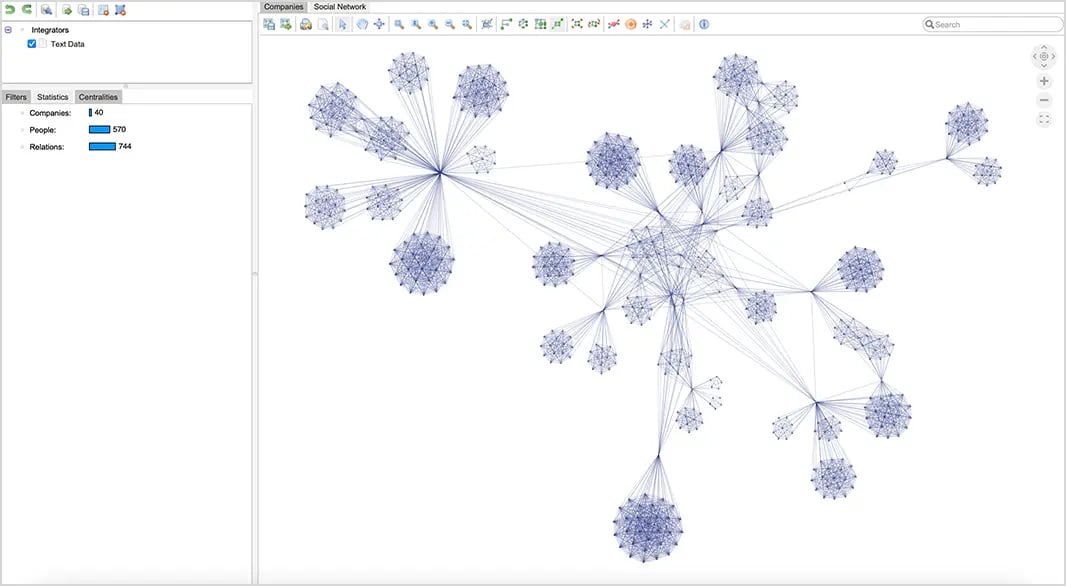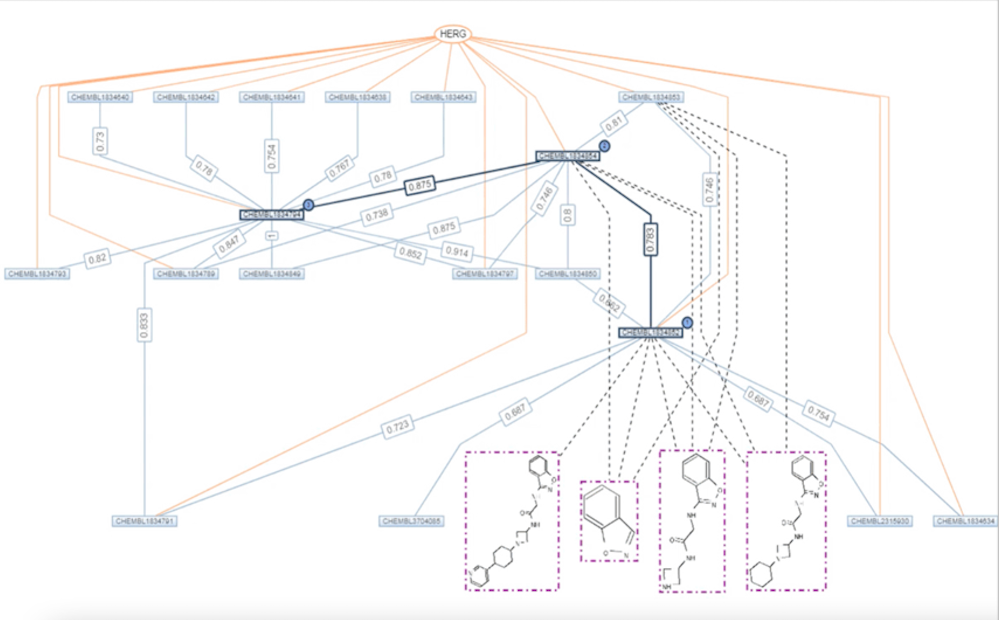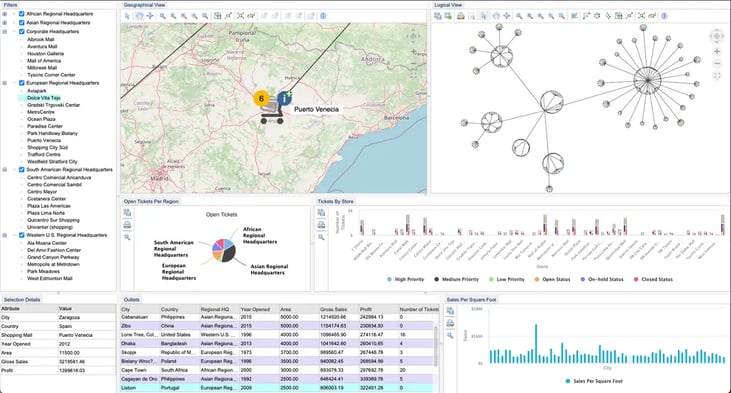In our digitally dominated era, where data collection is ubiquitous, but extracting value from the data can be challenging, the methodologies we employ to parse, interpret, and leverage that data are critical. We collect vast amounts of atomic facts, which may or may not constitute useful information. Sifting out the noise and finding meaning in the data we are amassing continues to be challenging, even with remarkable advances in artificial intelligence.
Knowledge graphs stand out in information science as one of the most innovative and impactful approaches for turning data into knowledge. Knowledge graph data structures go beyond mere databases to represent information in a way that mirrors human cognitive processes, enabling a deeper, more contextual understanding of data.

An enterprise social network.
Knowledge graphs conceptualize data as entities and relationships, forming a web of interconnected information that is both rich and navigable. This approach not only enhances data retrieval and analysis but also opens new avenues for artificial intelligence, machine learning, and semantic technologies to flourish.
The importance of knowledge graphs in today's data-driven world cannot be overstated. They provide the backbone for a range of applications, from enhancing search engine capabilities to powering recommendation systems, and from streamlining operations in healthcare and finance to offering groundbreaking insights in research and development.
As we review knowledge graph use cases, we begin to appreciate their role not just as a technological tool, but as a transformative force reshaping how we interact with the digital world.
Understanding Knowledge Graphs
Knowledge Graph Use Cases are diverse and span all industries, fundamentally because of what knowledge graphs are at their core. A knowledge graph is a comprehensive way to organize and represent information in a graph structure, where entities (nodes) are interconnected by relationships (edges), creating a network of related information. This structure facilitates knowledge representation and reasoning, allowing for complex queries and insights that traditional relational databases struggle to provide.
How Knowledge Graphs Work
At the heart of knowledge graphs lies the principle of knowledge representation and reasoning, so that the data we collect can be stored along with what that data means, and how it can be interpreted, within some context. The knowledge that can be represented by a knowledge graph is described by an ontology (semantic meta-model) that provides data definitions that are both human and machine-interpretable, and interoperable with other data sets.
By encoding information in a graph format consistent with an ontology, the graph structure enables semantic web technologies to interpret the relationships and properties of interconnected data points, turning individual data points into useful knowledge. This approach allows for more nuanced and context-aware information retrieval, enhancing the ability of systems to understand user queries and deliver relevant, precise results.
The Impact of Knowledge Graphs Across Industries
Healthcare: Enhancing Patient Care and Medical Research
Semantic web technologies have found a significant application in healthcare through knowledge graphs. By integrating disparate data sources, such as patient records, research studies, and clinical trials, knowledge graphs offer a holistic view of medical knowledge. This interconnected data environment enhances patient care by providing healthcare professionals with comprehensive insights into patient histories, potential treatment paths, and outcomes. Additionally, it accelerates medical research by uncovering hidden patterns and relationships within vast datasets, driving innovations in drug discovery and disease understanding.

A knowledge graph of the chemical composition of a drug.
Finance and Banking: Revolutionizing Risk Management and Compliance
In finance and banking, knowledge graph examples demonstrate their capability to transform risk management and compliance processes. By mapping the complex network of transactions, customer relationships, and regulatory requirements, knowledge graphs facilitate a more effective identification and analysis of financial risks. This visibility not only aids in compliance with ever-evolving regulations but also enhances decision-making in investment strategies and fraud detection, illustrating the profound impact of knowledge graphs on the industry.

Graph visualization and timeline of suspicious transactions.
Knowledge Graphs in the Digital Era
Boosting Search Engine Efficiency and Personalization
Semantic web technologies play a crucial role in enhancing the efficiency and personalization of search engines through knowledge graphs. By understanding the context and intent behind user queries, knowledge graphs enable search engines to deliver more accurate and relevant results. This tailored search experience leverages the interconnected nature of data, improving information retrieval and user satisfaction in the digital age.
Enabling Advanced IoT Applications
Knowledge Graph Use Cases extend into the realm of the Internet of Things (IoT), where they facilitate the integration and analysis of data from billions of connected devices. By providing a unified view of IoT data, knowledge graphs enable advanced applications, such as smart cities, personalized healthcare monitoring, and efficient energy management, showcasing their versatility and impact in harnessing IoT's potential.

A large graph visualization that highlights connections and relationships between connected devices.
Case Studies: Real-World Applications of Knowledge Graphs
NASA’s Space Exploration Data Analysis
NASA’s utilization of knowledge graphs for space exploration data analysis exemplifies their power in managing and interpreting complex datasets. By linking data from various missions, research findings, and astronomical observations, NASA’s knowledge graph provides a comprehensive framework for uncovering insights about space phenomena, enhancing the efficiency of future missions and scientific research.
E-commerce: Personalizing Customer Experience
In e-commerce, knowledge graphs contribute to personalizing the shopping experience by analyzing customer behavior, preferences, and interactions. This analysis helps businesses tailor product recommendations, improve search functionality, and create targeted marketing campaigns, thereby elevating the customer experience and driving sales.
Cybersecurity: Enhancing Threat Intelligence
The application of knowledge graphs in cybersecurity enhances the detection and prediction of cyber threats. By mapping the digital footprint of an organization’s network, including devices, applications, and user interactions, knowledge graphs identify vulnerabilities and potential attack paths. This proactive approach to threat intelligence supports more robust security measures and informed response strategies.

A global retail network of devices and connections.
Future Directions: The Evolution of Knowledge Graphs
The future of knowledge graphs is marked by continuous innovations and emerging trends in knowledge representation and reasoning. Advancements in AI and machine learning are expected to further enhance the capabilities of knowledge graphs, enabling more sophisticated data analysis, prediction models, and automated reasoning. These developments promise to expand the applicability, affordability, and effectiveness of knowledge graphs across even more industries and domains.
Challenges and Opportunities Ahead
As knowledge graphs continue to evolve, they face challenges such as data quality, scalability, and integration with legacy systems. However, these challenges also present opportunities for innovation, such as the development of more efficient data ingestion and processing techniques, and the creation of new standards for knowledge graph interoperability. Embracing these challenges and opportunities will be key to unlocking the full potential of knowledge graphs.
Conclusion: Harnessing the Power of Knowledge Graphs for Future Innovations
Knowledge graphs stand at the forefront of the data-driven revolution, offering unparalleled capabilities in organizing, analyzing, and applying knowledge across various domains. By embracing knowledge graph technologies, businesses and researchers can unlock new levels of insight, efficiency, and innovation. As we look to the future, the continued evolution and application of knowledge graphs will undoubtedly play a crucial role in shaping our digital world, driving forward advancements in industry, science, and society at large.
About the Author
Liana Kiff is a Senior Consultant, bringing more than 25 years of software innovation, design, and development experience to Tom Sawyer Software. Prior to Tom Sawyer Software, Liana worked on graph-based approaches to industrial information management at Honeywell’s corporate labs, where she acquired deep domain knowledge related to commercial, and industrial customers of advanced control solutions. As a champion of information standards and model-driven approaches, she led the development of a common ontology for use across a wide range of building automation solutions and managed the development of cloud-based services and APIs for enterprise software development. Liana holds a Master of Software Engineering degree from the University of Minnesota.
FAQ:
How can knowledge graphs assist in managing and reducing data silos within organizations?
Knowledge graphs break down data silos by integrating disparate data sources into a unified structure where relationships between data points are clearly defined. By connecting previously isolated data sets from different departments, systems, or tools, knowledge graphs create a holistic view of information across the organization. This enables better collaboration, improved decision-making, and a more seamless flow of information.
What are some of the challenges organizations face when scaling knowledge graphs?
As knowledge graphs grow in size and complexity, scalability challenges arise regarding data processing speed, storage capacity, and query performance. Managing large volumes of interconnected data can strain computational resources, requiring robust infrastructure and optimized graph databases. Another significant challenge is ensuring consistent data quality and preventing performance bottlenecks as more nodes and relationships are added. Organizations need to implement effective scaling strategies, such as distributed databases or partitioning, to maintain graph efficiency.
Can knowledge graphs be used to improve supply chain transparency and efficiency?
Yes, knowledge graphs are powerful tools for enhancing supply chain transparency by mapping out the relationships between suppliers, manufacturers, distributors, and customers. Knowledge graphs help organizations identify inefficiencies, predict potential disruptions, and optimize logistics by providing a visual representation of supply chain components and interactions. This real-time visibility allows for more efficient decision-making, reducing costs and improving supply chain resilience.
Can knowledge graphs be used for time-series data analysis, and how?
Yes, knowledge graphs can be adapted to handle time-series data by incorporating temporal aspects into nodes and relationships. For example, entities can be linked to specific time points, allowing the graph to represent changes over time. This is particularly useful in fields like finance or healthcare, where tracking how relationships evolve can provide deeper insights into trends, patterns, and anomalies in time-sensitive data.

Submit a Comment